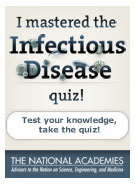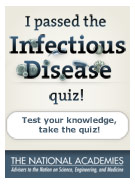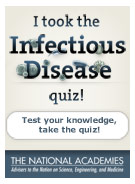
What You Need To Know About Infectious Disease
What do you know about infectious disease?
Public health officials can identify the outbreak of disease by monitoring certain patterns of behavior through syndromic surveillance. Which of the following is one of the signs used to identify a disease outbreak using this system?
- Level of school and work absenteeism
- Sales of over-the-counter medication
- Number of illness-related 911 calls
- All of the above
-
Sorry, that’s incorrect.
In syndromic surveillance, all of the above are used in addition to other patterns that suggest an outbreak. Despite the emergence of this innovative surveillance method, most surveillance still depends on tracking reported infections.
-
Sorry, that’s incorrect.
In syndromic surveillance, all of the above are used in addition to other patterns that suggest an outbreak. Despite the emergence of this innovative surveillance method, most surveillance still depends on tracking reported infections.
-
Sorry, that’s incorrect.
In syndromic surveillance, all of the above are used in addition to other patterns that suggest an outbreak. Despite the emergence of this innovative surveillance method, most surveillance still depends on tracking reported infections.
-
Correct!
In syndromic surveillance, all of the above are used in addition to other patterns that suggest an outbreak. Despite the emergence of this innovative surveillance method, most surveillance still depends on tracking reported infections.
About what percentage of the antibiotics produced in the United States is added to animal feeds to promote growth?
-
Sorry, that’s incorrect.
Almost 70% of all the antibiotics produced in the United States is added to animal feeds—not to fend off disease but to boost growth. These non-therapeutic uses of antibiotics are a perfect way to cultivate microbes that are resistant to antibiotics.
-
Sorry, that’s incorrect.
Almost 70% of all the antibiotics produced in the United States is added to animal feeds—not to fend off disease but to boost growth. These non-therapeutic uses of antibiotics are a perfect way to cultivate microbes that are resistant to antibiotics.
-
Correct!
Almost 70% of all the antibiotics produced in the United States is added to animal feeds—not to fend off disease but to boost growth. These non-therapeutic uses of antibiotics are a perfect way to cultivate microbes that are resistant to antibiotics.
Which are larger?
-
Correct!
Bacteria are 10 to 100 times larger than viruses.
-
Sorry, that’s incorrect.
Bacteria are 10 to 100 times larger than viruses.
Each year, how many Americans become infected by what they eat?
-
Sorry, that’s incorrect.
Each year about 76 million Americans—or one in four—become infected by what they eat. Approximately 325,000 are hospitalized. More than 5,000 (14 a day) die.
-
Sorry, that’s incorrect.
Each year about 76 million Americans—or one in four—become infected by what they eat. Approximately 325,000 are hospitalized. More than 5,000 (14 a day) die.
-
Correct!
Each year about 76 million Americans—or one in four—become infected by what they eat. Approximately 325,000 are hospitalized. More than 5,000 (14 a day) die.
Which of the following is NOT a type of infectious agent?
-
Sorry, that’s incorrect.
White blood cells are not a type of infectious agent. Part of the immune system, white blood cells fight infection rather than cause it.
-
Sorry, that’s incorrect.
White blood cells are not a type of infectious agent. Part of the immune system, white blood cells fight infection rather than cause it.
-
Correct!
White blood cells are not a type of infectious agent. Part of the immune system, white blood cells fight infection rather than cause it.
-
Sorry, that’s incorrect.
White blood cells are not a type of infectious agent. Part of the immune system, white blood cells fight infection rather than cause it.
True or False: Not all microbes are harmful to humans.
-
Correct!
Not all microbes are harmful to humans. In fact, many of them protect us, helping our bodies function properly and competing with harmful organisms in an eternal contest for habitable space in or on our bodies. Although the microorganisms that cause disease often receive more attention, most microorganisms do not cause illness.
-
Sorry, that’s incorrect.
Not all microbes are harmful to humans. In fact, many of them protect us, helping our bodies function properly and competing with harmful organisms in an eternal contest for habitable space in or on our bodies. Although the microorganisms that cause disease often receive more attention, most microorganisms do not cause illness.
Which reproduce the fastest:
-
Sorry, that’s incorrect.
Viruses reproduce the fastest. Humans produce a new generation every 20 years or so; bacteria do it every 20 to 30 minutes, and viruses even faster.
-
Sorry, that’s incorrect.
Viruses reproduce the fastest. Humans produce a new generation every 20 years or so; bacteria do it every 20 to 30 minutes, and viruses even faster.
-
Correct!
Viruses reproduce the fastest. Humans produce a new generation every 20 years or so; bacteria do it every 20 to 30 minutes, and viruses even faster.
True or False: Scientists predict that rising average temperatures in some regions will change the transmission dynamics and geographic range of cholera, malaria, dengue fever, and tick-borne diseases.
-
Correct!
Scientists predict that rising average temperatures in some regions—a result of climate change—will change the transmission dynamics and geographic range of cholera, malaria, dengue fever, and tick-borne diseases.
-
Sorry, that’s incorrect.
Scientists predict that rising average temperatures in some regions—a result of climate change—will change the transmission dynamics and geographic range of cholera, malaria, dengue fever, and tick-borne diseases.
Which of these viral diseases has the most antiviral drugs available to treat it?
-
Sorry, that’s incorrect.
Today there are more antiviral drugs available for HIV than for any other viral disease, transforming an infection that was once considered a death sentence into a manageable chronic condition.
-
Correct!
Today there are more antiviral drugs available for HIV than for any other viral disease, transforming an infection that was once considered a death sentence into a manageable chronic condition.
-
Sorry, that’s incorrect.
Today there are more antiviral drugs available for HIV than for any other viral disease, transforming an infection that was once considered a death sentence into a manageable chronic condition.
-
Sorry, that’s incorrect.
Today there are more antiviral drugs available for HIV than for any other viral disease, transforming an infection that was once considered a death sentence into a manageable chronic condition.
Thank you for taking our quiz.
Place this badge on your Facebook page to show your friends what you know about infectious disease.
Place this badge on your Facebook page to show your friends what you know about infectious disease.
OR, get a higher score to unlock a different badge.
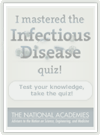
Place this badge on your Facebook page to show your friends what you know about infectious disease.
OR, get a higher score to unlock a different badge.
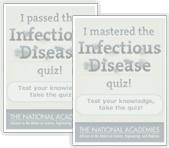
Explore Other Topics
Disease Watchlist
Infectious Disease Defined
- Encephalitis
Inflammation of the brain, often caused by a virus.
